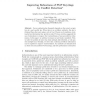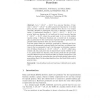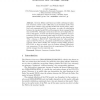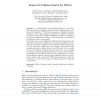CTRSA
2004
Springer
15 years 4 months ago
2004
Springer
We present a cryptanalysis of a zero-knowledge identification protocol introduced by Naccache et al. at Eurocrypt '95. Our cryptanalysis enables a polynomial-time attacker to ...
119
click to vote
CTRSA
2004
Springer
15 years 4 months ago
2004
Springer
Abstract. Secure authentication frequently depends on the correct recognition of a user's public key. When there is no certificate authority, this key is obtained from other u...
CRYPTO
2004
Springer
15 years 4 months ago
2004
Springer
Let f : {0, 1}n {0, 1}l be a one-way function. A function h : {0, 1}n {0, 1}m is called a hard-core function for f if, when given f(x) for a (secret) x drawn uniformly from {0, 1}n...
CRYPTO
2004
Springer
15 years 4 months ago
2004
Springer
Abstract. We study the problem of broadcasting confidential information to a collection of n devices while providing the ability to revoke an arbitrary subset of those devices (and...
109
click to vote
ASIACRYPT
2006
Springer
15 years 4 months ago
2006
Springer
We propose a new type of guess-and-determine attack on the self-shrinking generator (SSG). The inherent flexibility of the new attack enables us to deal with different attack condi...
ASIACRYPT
2006
Springer
15 years 4 months ago
2006
Springer
Abstract. Recently, Bellare and Palacio succeeded in defining the plaintext awareness, which is also called PA2, in the standard model. They propose three valiants of the standard ...
ASIACRYPT
2006
Springer
15 years 4 months ago
2006
Springer
Pseudorandom Generators (PRGs) based on the RSA inversion (one-wayness) problem have been extensively studied in the literature over the last 25 years. These generators have the a...
ASIACRYPT
2006
Springer
15 years 4 months ago
2006
Springer
At CRYPTO2005, Xiaoyun Wang, Hongbo Yu and Yiqun Lisa Yin proposed a collision attack on SHA-0 that could generate a collision with complexity 239 SHA-0 hash operations. Although t...
129
click to vote
ASIACRYPT
2006
Springer
15 years 4 months ago
2006
Springer
Abstract. Stream ciphers play an important role in symmetric cryptology because of their suitability in high speed applications where block ciphers fall short. A large number of fa...
116
click to vote
ASIACRYPT
2006
Springer
15 years 4 months ago
2006
Springer
In this paper, we describe generic attacks on unbalanced Feistel schemes with contracting functions. These schemes are used to construct pseudo-random permutations from kn bits to ...




